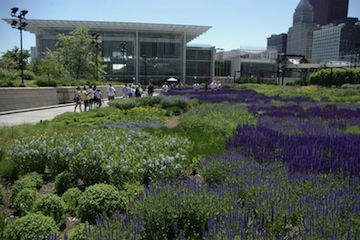
Renzo Piano Building Workshop, Modern Wing of the Art Institute of Chicago, 2009. Image via Flickr. Photo by Andrew Ciscel.
It’s hip to be high-minded these days. In the cultural spheres, showing awareness of environmental concerns can prove to be a savvy PR move, and architectural firms and museum committees have taken note. Eco-friendly design in natural history and science museums is not, in this day and age, surprising at all, and art centers are increasingly taking their cue from construction successes across the country. The planners, designers, builders, check-writers — all have a keen eye toward fusing the architecture with the land, and for decreasing ecological impact through cutting-edge green technology.
On the aesthetic side, there is a rising push for integrating the walls of museums with the natural elements of their physical site. Diller Scofio + Renfro’s previous projects — notably their daring design for Boston’s Institute of Contemporary Art, which takes full advantage of harbor waterfront views — seem to have paid off, as the firm is the rumored frontrunner for masterminding has been selected to design Eli Broad’s new museum. Alice Walton’s Crystal Bridges Museum of American Art, which just broke ground in Arkansas, features sweeping panoramas of the surrounding ravine, or what architect Moshe Safdie calls “responding to the essence of place.” Shigeru Ban’s proposed design for the new Aspen Art Museum will similarly react to and highlight the natural landscape setting.
Diller Scofidio + Renfro Architects, Poss Family Mediatheque, ICA Boston, 2006. Image via museum website. Photo by Iwan Baan. The large angled windows give the sense that one is floating above the water.
As for the practical side, the philosophy of sustainability has established new standards for energy efficiency and conservation efforts. Perhaps before it influenced art centers, this attitude guided the design of natural history and science museums (note: one of the foremost recent examples, Renzo Piano’s remodeled California Academy of Sciences features its own living roof and four-story indoor rainforest). The trend in art buildings has not lagged far behind, with the websites for many design conglomerates, such as Snøhetta (which SFMOMA recently selected for its expansion), conspicuously stating and promoting their sustainable design missions.
In February of this year, Boston public radio station WBUR focused on the surge in efforts among three local art institutions — the Museum of Fine Arts, Harvard Art Museums, and even the Isabella Stewart Gardner Museum — to go green. Similar campaigns are popping up in established organizations everywhere across the country, such as at the Seattle Art Museum. While these noble crusades for incorporating green strategies into existing structures are certainly to be admired and encouraged, to me the more interesting developments are to be found in newer cultural institutions that incorporate sustainability into their mission and design from their very inception. In these examples, the integration between art and nature is more all-inclusive and palpable to the naked eye, and hint toward the architectural and design practices of the future. The U.S. Green Building Council’s Leadership in Energy and Environmental Design (LEED) has certified new buildings, expansions, or renovations for the Burchfield Penney Art Center, the Provincetown Art Association and Museum, and Grand Rapids Art Museum, with certification expected for the museum of the Art Institute of Chicago later this year. The phrase “LEED-certified” certainly sparks the public’s interest and wins nods of approval.
Herzog & de Meuron's proposed Miami Art Museum in Museum Park, Miami. Image via MAM website, visualization by Artefactorylab.
The most exciting architectural project underway is the upcoming Miami Art Museum (MAM), designed by the Swiss firm Herzog & de Meuron, which is slated to open in 2013. The building will be situated within a 29-acre park and will overlook Biscayne Bay. The architects are aiming to integrate the surrounding green space into the design through shaded veranda and plazas, columns of vegetation, landscaping and terraces, and an overhanging canopy perforated to allow in natural light. Green technology such as geothermal cooling will help to regulate temperature and humidity levels, and wind, rain, and solar power will aid in providing energy with minimal environmental impact. The new MAM is being conceived like a living, breathing organism, intended to “expand organically from within without major interruptions,” as “fluid interior volumes” allow for easy gallery expansions and re-design without dampening visitor traffic. Certainly it’s a project to follow.
But what about outside of the mega-museum sphere? My search for similar eco-friendly architectural plans and operating practices in smaller galleries and non-traditional arts venues uncovered nothing. This didn’t come as much of a shock, as these places are less likely to enjoy the luxury of big budgets — and big scope — necessary for charting and executing such design overhauls. They are far more apt to explore principles of environmentalism from the educational and curatorial perspectives … but will this change? Or am I simply unaware of unsung efforts among small independent spaces, small-town alternative galleries, and community non-profits to reduce their footprints and pave new paths? I’d love to hear your views on the matter; please share your insight or personal experiences in the comments, and shed light on how our eco-mania can be exercised on the smaller scale.